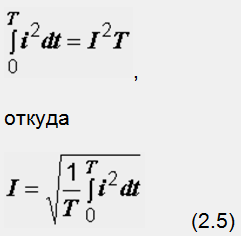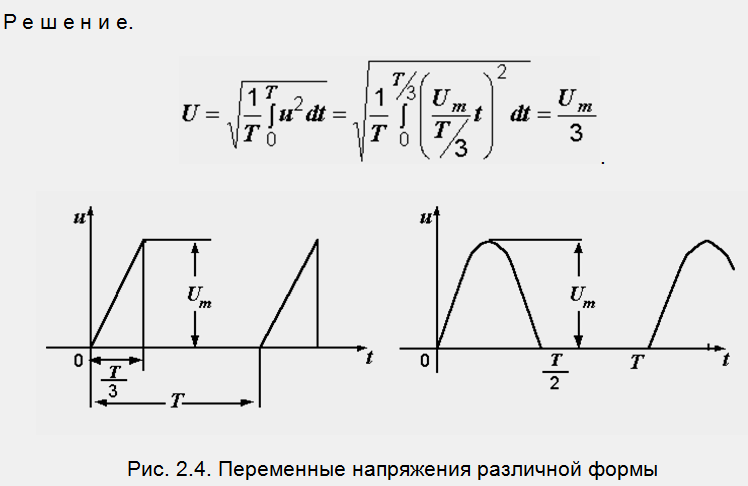Peak voltage mains 220. Effective, effective voltage, current strength. Value
Lectures on TOE / No. 13 Actual value of alternating current.
The concept of the effective value of the current is introduced in connection with the need to make measurements. What to measure in AC? If we dealt only with sinusoids - curves of the same form, then it would be possible to measure amplitudes. But in practice, there are a variety of curves, and it may be that two different-shaped currents have the same amplitude, although it is obvious that they will have a different effect on the electrical circuit.
Therefore, it is most expedient to estimate the magnitude of the current for the work that it does. With such an assessment, the effect of alternating current is compared with that of direct current. For example, if a certain alternating current generates the same amount of heat in a circuit as a direct current of 10 amperes, then it is said that the value of this alternating current is 10 amperes. This value of the current is called acting.
So, the effective value of an alternating current is called the numerical value of such a direct current, which for a time equal to one period produces in the resistance the same amount of heat as the alternating current ..
Thus, to estimate the magnitude of the alternating current, we must do the following.
1. To determine the amount of heat released in the resistance R during the time T with the flow of alternating current i. This amount of heat is equal to:

2. To pick up such a constant current I, which for the same time T in the same resistance R produces the same amount of heat. At constant current, it is equal to: W = I 2 RT.
3. Equate W = W:

The last formula determines the effective value of alternating current.
Example 2.1. A triangular-shaped impulse voltage is applied to the input of a certain circuit (Fig. 2.4, a). What is its actual value?

Example 2.2. In fig. 2.4, b shows the voltage curve at the output of a single-phase half-wave rectifier circuit. What is the effective value of voltage, if its amplitude value Um is 311 V?

Example 2.3. Determine the effective value of the sinusoidal current i = I m sin (ωt):

The considered examples show that the effective value of alternating current depends on its shape.
We wish you a successful study of the material and successful delivery!
AC for a long time did not find practical application. This was due to the fact that the first generators of electrical energy produced direct current, which completely satisfied the technological processes of electrochemistry, and the DC motors had good control characteristics. However, as production developed, direct current increasingly less began to meet the increasing demands of an economical power supply. Alternating current made it possible to efficiently crush electrical energy and change voltage with the help of transformers. The possibility of producing electricity at large power plants, followed by its economical distribution to consumers, has increased, and the radius of power supply has increased.
Currently, the central production and distribution of electrical energy is carried out mainly on alternating current. Circuits with varying - alternating - currents compared to DC circuits have a number of features. Variable currents and voltages cause alternating electric and magnetic fields. As a result of changes in these fields in the chains, phenomena of self-induction and mutual induction occur, which have the most significant influence on the processes occurring in the chains, complicating their analysis.
Alternating current (voltage, emf, etc.) is the current (voltage, emf, etc.) that changes over time. Currents whose values are repeated at regular intervals in the same sequence are called periodic,and the smallest time interval after which these repetitions are observed is period T. For a periodic current, we have
The range of frequencies used in technology: from ultralow frequencies (0.01¸10 Hz - in automatic control systems, in analog computing) - to ultrahigh (3000 300000 MHz - millimeter waves: radar, radio astronomy). In the Russian Federation industrial frequency f = 50Hz.
The instantaneous value of a variable is a function of time. It is usually denoted by a lowercase letter:
i - instantaneous current value;
u - instantaneous voltage value;
e - instantaneous value of EMF;
r- instantaneous value of power.
The largest instantaneous value of a variable over a period is called amplitude (it is usually denoted by an uppercase letter with the index m).
Current amplitude;
Voltage amplitude;
The amplitude of the EMF.
Ac current value
The value of the periodic current, equal to the value of the direct current, which during the same period will produce the same thermal or electrodynamic effect as the periodic current, is called effective valueperiodic current:
Similarly, the effective values of emf and voltage are determined.
Sinusoidal current
Of all the possible forms of periodic currents, the most common is sinusoidal current. Compared to other types of current, sinusoidal current has the advantage of allowing, in the general case, the most economical production, transmission, distribution and use of electrical energy. Only with the use of a sinusoidal current, it is possible to maintain unchanged the shape of the voltage and current curves in all parts of a complex linear circuit. The theory of sinusoidal current is the key to understanding the theory of other circuits.
The image of sinusoidal emf, voltage and current on the plane of Cartesian coordinates
Sinusoidal currents and voltages can be depicted graphically, written using equations with trigonometric functions, represented as vectors on a Cartesian plane or with complex numbers.
Given in Fig. 1, 2 graphs of two sinusoidal EMF e 1 and e 2 match the equations:
 The values of the arguments of the sinusoidal functions are called phasessine wave, and the phase value at the initial time (t=0):
and - initial phase(
).
The values of the arguments of the sinusoidal functions are called phasessine wave, and the phase value at the initial time (t=0):
and - initial phase(
).
The value characterizing the rate of change of the phase angle, called angular frequency.Since the phase angle of a sinusoid during one period T changes to rad., then the angular frequency is ![]() where f–frequency.
where f–frequency.
When considering jointly two sinusoidal quantities of the same frequency, the difference of their phase angles, equal to the difference of the initial phases, is called phase angle.
For sinusoidal emf e 1 and e 2 phase angle:
Vector image of sinusoidally varying values
On the Cartesian plane from the origin, vectors are taken that are equal in magnitude to the amplitude values of sinusoidal values, and rotate these vectors counterclockwise ( in TOE this direction is taken as positive) with an angular frequency equal to w. The phase angle during rotation is counted from the positive semi-axis of the abscissa. The projections of the rotating vectors on the y-axis are equal to the instantaneous values of the emf e 1 and e 2 (Fig. 3). The set of vectors representing sinusoidally varying emf, voltages and currents is called vector diagrams.When constructing vector diagrams, it is convenient to arrange vectors for the initial moment of time. (t=0), which follows from the equality of the angular frequencies of sinusoidal quantities and is equivalent to the fact that the system of Cartesian coordinates itself rotates counterclockwise with speed w. Thus, in this coordinate system, the vectors are fixed (Fig. 4). Vector diagrams are widely used in the analysis of sinusoidal current circuits. Their use makes the calculation of the circuit more intuitive and simple. This simplification consists in the fact that the addition and subtraction of the instantaneous values of quantities can be replaced by the addition and subtraction of the corresponding vectors.
|
|
Let, for example, at the branching point of the circuit (Fig. 5), the total current is equal to the sum of the two-branch current: 
When calculating AC circuits, one usually uses the concept of effective (effective) values of alternating current, voltage, and e. d.
Effective values of current, voltage and e. d. denoted by capital letters.
On the scales of measuring devices and technical documentation also indicates the effective values of quantities.
The effective value of alternating current is equal to the value of such an equivalent direct current, which, passing through the same resistance as the alternating current, emits the same amount of heat over a period.
The amount of heat released by the alternating current in the resistance for an infinitely small period of time
![]()
and for the period of alternating current T

Equating the resulting expression to the amount of heat released in the same resistance by direct current for the same time T, we get:

Reducing the common factor, we get the current value of the current


Fig. 5-8. Graph AC and square current.
In fig. 5-8, the curve of instantaneous values of current i and the curve of squares of instantaneous values are plotted. The area bounded by the last curve and the x-axis is, on some scale, the value determined by the expression The height of a rectangle of equal area bounded by the curve and the x-axis equal to current effective square
If the current changes according to the sine law, i.e.
![]()


Similarly for effective values of sinusoidal voltages and e. d. can write:
In addition to the effective values of current and voltage, sometimes they also use the concept of the mean value of the capacitance and voltage.
The average value of the sinusoidal current over the period is zero, since during the first half of the period a certain amount of electricity Q passes through the cross section of the conductor in the forward direction. During the second half of the period, the same amount of electricity passes through the conductor cross section in the opposite direction. Consequently, the amount of electricity passed through the conductor cross-section over a period is zero, zero and the average for the period is the value of the sinusoidal current.
Therefore, the average value of the sinusoidal current is calculated for the half period during which the current remains positive. The average value of the current is equal to the ratio of the amount of electricity that has passed through the conductor cross section over a half period to the duration of this half period.




